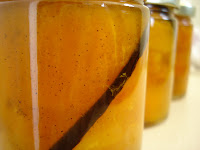Or is it a pudding? That's the great debate here with month's Daring Bakers' Challenge, the Bakewell Tart. The June Daring Bakers' challenge was hosted by Jasmine of
Confessions of a Cardamom Addict and Annemarie of
Ambrosia and Nectar. They chose a Traditional (UK) Bakewell Tart... er... pudding that was inspired by a rich baking history dating back to the 1800's in England.

Bakewell Tart History and Lore
Flan-like desserts that combine either sweet egg custard over candied fruit or feature spiced ground almonds in a pastry shell have Medieval roots. The term “Bakewell pudding” was first penned in 1826 by Meg Dods; 20 years later Eliza Acton published a recipe that featured a baked rich egg custard overtop 2cm of jam and noted,
“This pudding is famous not only in Derbyshire, but in several of our northern counties where it is usually served on all holiday occasions.”
By the latter half of the 1800s, the egg custard evolved into a frangipane-like filling; since then the quantity of jam decreased while the almond filling increased.
This tart, like many of the world's great foods has its own mythic beginnings…or several mythic beginnings. Legend has it in 1820 (or was it in the 1860s?) Mrs. Greaves, landlady of The White Horse Inn in Bakewell, Derbyshire (England), asked her cook to produce a pudding for her guests. Either her instructions could have been clearer or he should have paid better attention to what she said because what he made was not what she asked for. The cook spread the jam on top of the frangipane mixture rather than the other way around. Or maybe instead of a sweet rich shortcrust pastry case to hold the jam for a strawberry tart, he made a regular pastry and mixed the eggs and sugar separately and poured that over the jam—it depends upon which legend you follow.
Regardless of what the venerable Mrs. Greaves’ cook did or didn’t do, lore has it that her guests loved it and an ensuing pastry-clad industry was born. The town of Bakewell has since played host to many a sweet tooth in hopes of tasting the tart in its natural setting.
"Bakewell Tart History and Lore" is courtesy of Jasmine of Confessions of a Cardamom Addict, and Annemarie of Ambrosia and Nectar, where you can find even more juicy bits on the Bakewell Tart... er... Pudding.
Now, fortunately for me, I was
ready to make this tart. I had just recently spent another day in
Brentwood, picking cherries and apricots for jams, sauces, and the like, when along comes this challenge requiring, ahem, jam. Kismet, people.
The hard part became deciding which kind of jam to use. I had white cherry, black cherry, and vanilla apricot. All of which would be perfect with almond, I might add. But wait, I just happen to have 4 mini springform pans that were given to me as a gift so many years ago I couldn't even tell you (not out of embarrassment but simple forgetfulness), that I've never before used. I know, shameful.

But it is my lucky day. And as such, I even had a relatively successful crust experience. (Me + crust usually = unhappy face.) I don't know that I would use these particular vessels for this purpose again (the crust was very difficult to arrange in such small, high-sided pans) but they did come out quite dashing if you don't mind me going English on you for a spell.

In the given recipe, the quantity of jam used was up to the user. I added the greater quantity recommended (1 cup - split between 4 tarts in my case) and must say that I would have liked a tad more. As pointed out above that even throughout the history of the recipe, the jam to almond filling ratio dwindled, I think I would have preferred the olden days. Yes, more jam, please. I found the filling to be quite sweet and jam provided the perfect foil.
Thank you ladies, for another delicious challenge!
Please see Confessions of a Cardamom Addict and Ambrosia and Nectar for the Bakewell Tart... er... Pudding recipe.
 Apricots in Vanilla Honey Syrupinspired by Christine Ferber
Apricots in Vanilla Honey Syrupinspired by Christine Ferber1 pound ripe apricots
1/2 cup sugar
2 oz honey
1 vanilla bean, split lengthwise
Wash apricots, cut in half and remove pits. In a large bowl gently combine apricots sugar, honey and vanilla bean. Cover with plastic wrap and allow to macerate under refrigeration at least 2 hours or overnight.
Drain apricots, reserving liquid. Heat liquid in a large non-reactive pot and boil gently until the syrup reaches 220 degrees. Add apricot halves and vanilla bean; bring to a boil and cook for approximately 5 minutes. Pack in jars and seal according to your preferred method, or transfer to a medium bowl and store in the refrigerator. Makes approximately 1 pint (16 ounces).
These apricots are delicious as a jam or could be used in myriad baking applications.



 Apricots in Vanilla Honey Syrup
Apricots in Vanilla Honey Syrup





